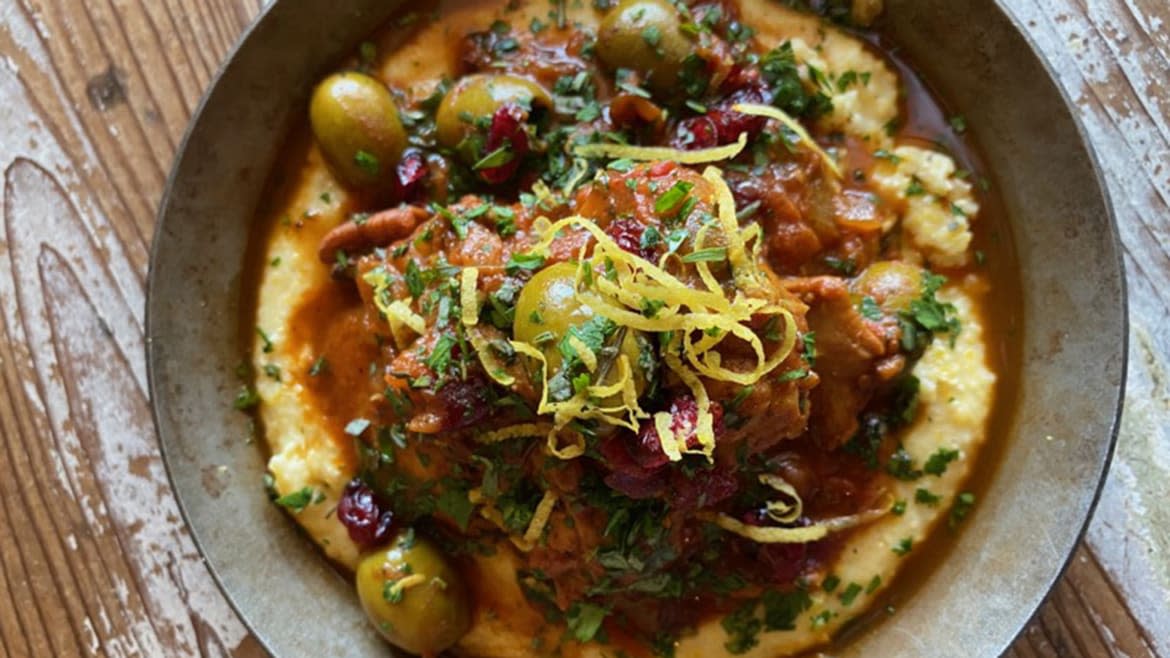This Chicken Stew Is What We All Need Right Now

The first time Chef Vishwesh Bhatt remembers eating Moroccan chicken stew was in France. It wasn’t long after he and his parents moved there from India, and it was Bhatt’s first time outside of his home country. He’d become friends with a boy his own age who invited him over for dinner.
“One time I went to their house and his mother offered me this couscous and chicken stew,” says Bhatt, who was named Best Chef in the South by the James Beard Foundation in 2019 for his cooking at Snackbar in Oxford, Mississippi. “It was familiar in a sense that there were some spices in there that I [recognized], but it was different from anything else that I’d tasted.”
It’s Time to Make Andrew Zimmern’s Tuna Noodle Casserole
We’ve Reached the Pasta Bolognese Phase of 2020
When he asked what was in the tomato-based stew, he was surprised to learn that it was almost all the same spices his mother used in her Indian cooking.
“That was the first time I had food that I thought of as foreign food,” says Bhatt. “It was my first exposure to immigrant cuisine. I like going back to that story because dishes like that tell those stories and it’s also something that sort of crosses a lot of cultural boundaries.”
That dish has stuck with Bhatt ever since. While he doesn’t remember exactly what was in the stew that his friend’s mother made, he’s recreated it countless times. Bhatt has included various iterations of it on Snackbar’s menu since it opened in 2009. He will often incorporate elements from not only classic Moroccan cuisine, but also from his Indian upbringing as well as local Mississippi ingredients.

“If a Moroccan person saw it, they would probably laugh at it,” says Bhatt. “But it started many years ago for me and has evolved.”
Whereas a classic Moroccan chicken stew might include almonds, dried apricots and raisins, he opts to swap in figs and pecans. Along with more than a dozen spices, it all melds together into a sweet, savory and all-around “nourishing” dish that’s great in cooler weather, but “isn’t season dependent.”
So start your autumn by making his delicious Moroccan-ish dish.
THE CHICKEN & BASE
While this dish is largely hands-off for most of the cooking process, it does take a little upfront preparation to ensure maximum flavor payoff. Bhatt’s recipe starts off by browning the chicken thighs in oil, and then doing the same with onion and garlic to give it a richer, more caramelized flavor.
And don’t worry about removing any of the fat that comes to the surface while cooking. “There will be a layer of fat that’s going to inevitably happen when you do something like this,” says Bhatt. “I just throw it back in.”
THE SPICES
One of Chef Bhatt’s favorite elements of this dish—and of North African foods in general, be it Moroccan, Tunisian or Algerian—is its heavy use of spices. But the chef wants to make one thing clear: This stew is spicy, but it’s not that kind of spicy.
“When we say spicy in America, we almost always mean hot like with pepper,” says Bhatt. “I have trouble with that because I grew up eating spicy food that doesn’t always have pepper in it. And so this is one of those dishes that makes it easy to demonstrate that you can have a good bit of spice on something without it being hot. It’s not going to sear your tongue.”
Though it does use crushed red pepper flakes, most of the spiced flavor in this dish comes from the addition of saffron and cinnamon. He also creates a Moroccan seasoning mix that includes more than a dozen spices and dried herbs, including rosemary, coriander and turmeric.
Bhatt insists that all of the spices used in the mix are likely already in your pantry or can be easily found at your local grocery store. “I can buy all those spices in Oxford, Mississippi, so people have no excuse anywhere else in the world to not make it,” he says.
THE EXTRAS
True to a traditional Moroccan chicken stew, Bhatt’s recipe centers on the classic balance of rich, spicy, savory, fruity and nutty flavors. He uses chopped, dried figs, green olives, sliced lemon wheels and pecans—but that’s just a guide to how you can build your own stew.
Any recipe is “sort of a template,” says Bhatt. “Feel free to tweak it, but don’t go too far away. Make use of what’s available and make something that tastes good to you, because what’s good for me is not necessarily good for somebody else.”
The figs and pecans can both easily be swapped out for something that’s more in line with your taste or depending on seasonal availability. “You can leave the figs out or cut them in half, use fewer of them,” says Bhatt. “The dried figs could easily be [swapped for] apricot or raisins, and dried cranberries work really well.”
While almonds are the more common choice in Moroccan stew, he uses pecans instead. They’re available year-round in Mississippi and provide a hint of local flavor to the stew. Use either for a delicious nutty addition or try it with pistachios or walnuts.
THE SIMMER
Once everything goes in the pot, you have two options: cook it down on the stovetop, or just throw it right into the oven and ignore it for a while.
“If I don’t want to keep an eye on it for too long, I cover it up, stick in the oven. Then I can sit back and have some friends over, put out a bottle of wine and by the time we’re done with that first bottle of wine, dinner is ready,” says Bhatt. “When you do it on the stovetop, it’s a little bit faster, but then also you have to pay a little more attention to it because there’s a chance of scorching as there are some sugars in there.”
THE FEAST
Come serving time, your biggest decision is how you’re going to soak up every last drop of sweet and savory goodness. Bhatt’s tried many different things over the years, serving a version of the stew at Snackbar over grits, couscous or rice pilaf—even serving it on its own with crusty bread. He also recalls it being equally delicious eaten with plain old white bread.
“It’s really versatile,” he says. “You can eat it like I used to when I was really lazy; I would just throw some white bread [in there] and have that. The main thing for anybody that’s cooking is to have fun with it. Don’t stress out—it’s only lunch. It’s just a medium to get people together and to talk and have a good time.”
Moroccan-ish Chicken Stew
By Vishwesh Bhatt
INGREDIENTS
12 large Chicken thighs, skin removed
3 cups Yellow onions, diced
2 Tbsp Garlic, minced
4 cups Ripe tomatoes, diced
4 cups Canned plum tomatoes, crushed and juices reserved
4 cups Unsalted chicken broth
1 generous pinch Saffron
1 Cinnamon stick
1 large Lemon, sliced
1.5 cups Dry figs, chopped
1.5 cups Green olives (such as Castelvetrano or picholine)
1.5 cups Pecans, toasted and chopped
1.5 Tbsp Moroccan seasoning*
1.5 tsp Crushed red pepper flakes
Salt & black pepper
.25 cup Olive oil
DIRECTIONS
Season the chicken thighs generously with salt and pepper and set aside at room temperature for 20 minutes.
Heat half the oil in a large Dutch oven and brown the chicken thighs in batches and set aside.
Add the remaining oil and sauté the onions until they start to brown just a bit. Add the garlic and sauté for an additional 3 minutes. Add the tomatoes, lower the heat to medium and cook until almost all the water has cooked out of them (about 20 minutes). Add the cinnamon stick, figs, olives, lemon slices, Moroccan seasoning, figs and red pepper flakes. Stir, and cook until the spices are fragrant (about 3-4 minutes). Add the broth and the browned chicken thighs, and bring to a simmer. Cover and cook on low heat until the chicken is falling apart tender (about 40 minutes). Carefully lift the cover and stir in the pecans. Season with salt. Cover and let the stew stand for 15 to 20 minutes before serving.
Note: If you wish, you can put the pot in a 325 °F oven for one to one-and-a-half hours instead of simmering on the stove top.
*Moroccan Seasoning
INGREDIENTS
1 Tbsp Garlic powder
1 Tbsp Fresh cracked black pepper
1 Tbsp Fennel seeds, toasted and crushed
1 Tbsp Dry English mustard powder
1 Tbsp Kosher salt
1 Tbsp Cumin seeds, toasted and crushed
1 Tbsp Coriander seeds, toasted and crushed
.5 Tbsp Cayenne
.5 Tbsp Dry rosemary, crushed
1 tsp Turmeric
.5 tsp Cardamom powder
.5 tsp Ground cinnamon
.25 tsp Grated nutmeg
DIRECTIONS
Mix all the ingredients together and store in a dry, airtight container.
Get our top stories in your inbox every day. Sign up now!
Daily Beast Membership: Beast Inside goes deeper on the stories that matter to you. Learn more.

